Artists publishing/log
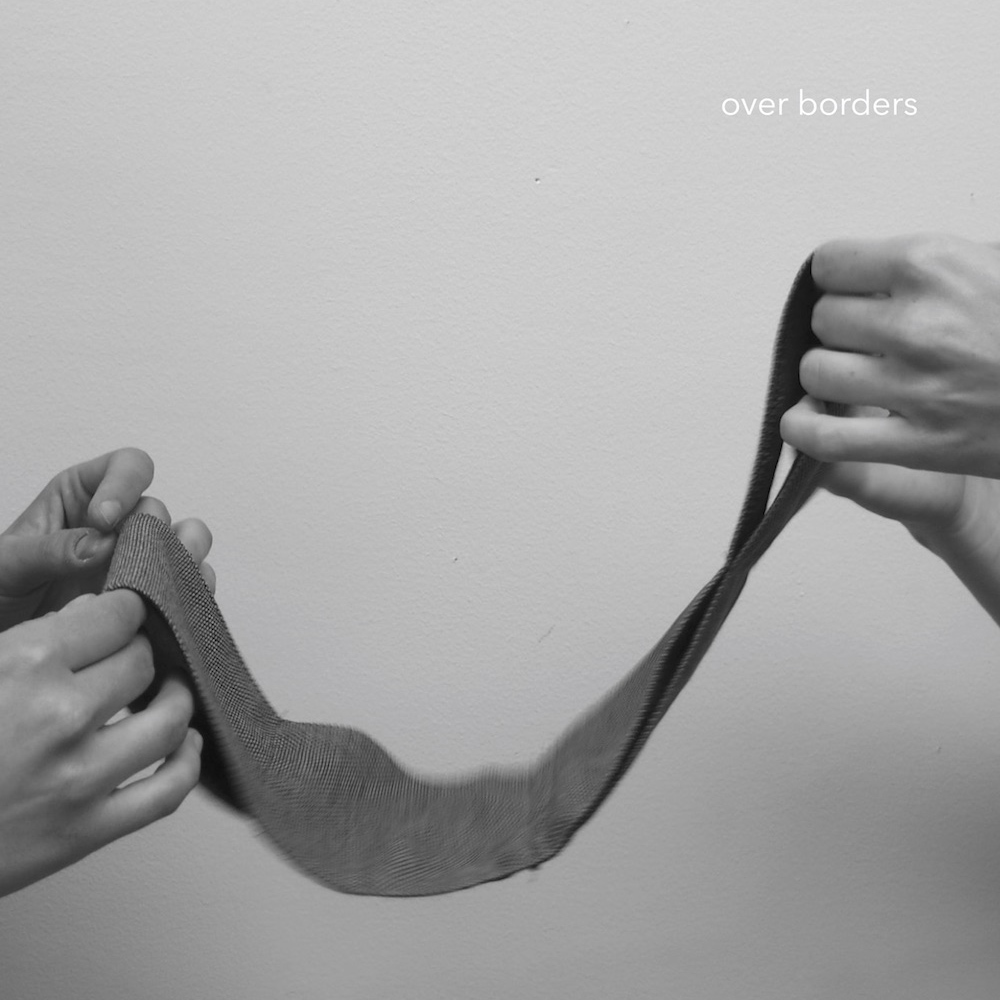
“This collection began as an idea to share some of our own scores* connected to the act or effects of borders, which we then expanded to include work by others in our creative communities. Artists / composers were asked to send scores that, in some way, referenced borders; social, political, virtual, perceptual, environmental or between species.”
Curated by Jez riley French and Pheobe riley Law
Self-published, April 2021
[52] pagesPDF (20 MB)
Henry Flynt: Blueprint for a Higher Civilization (1975)
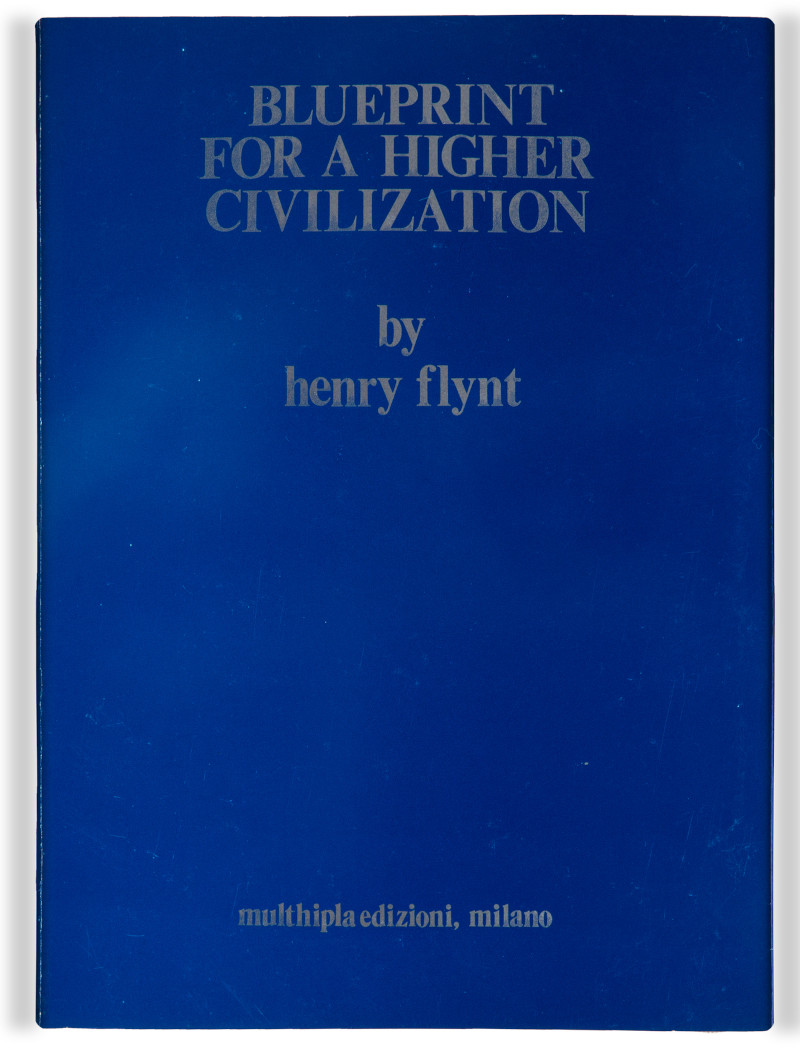
Book collects the artist’s early philosophical writings on concept art (Flynt coined the term in 1961) and cognitive nihilism. Includes photographs by Jack Smith and Tony Conrad of Flynt’s anti-art demonstrations against MoMA and the Lincoln Center in 1963.
Edited by Germano Celant
Publisher Multhipla, Milan, October 1975
206 pages
via NouratharPDF (28 MB, broken link has been fixed on 2021-2-1)
Adam Pendleton: Black Dada: What Can Black Dada Do for Me Do for Me Black Dada, a Reader (2017)
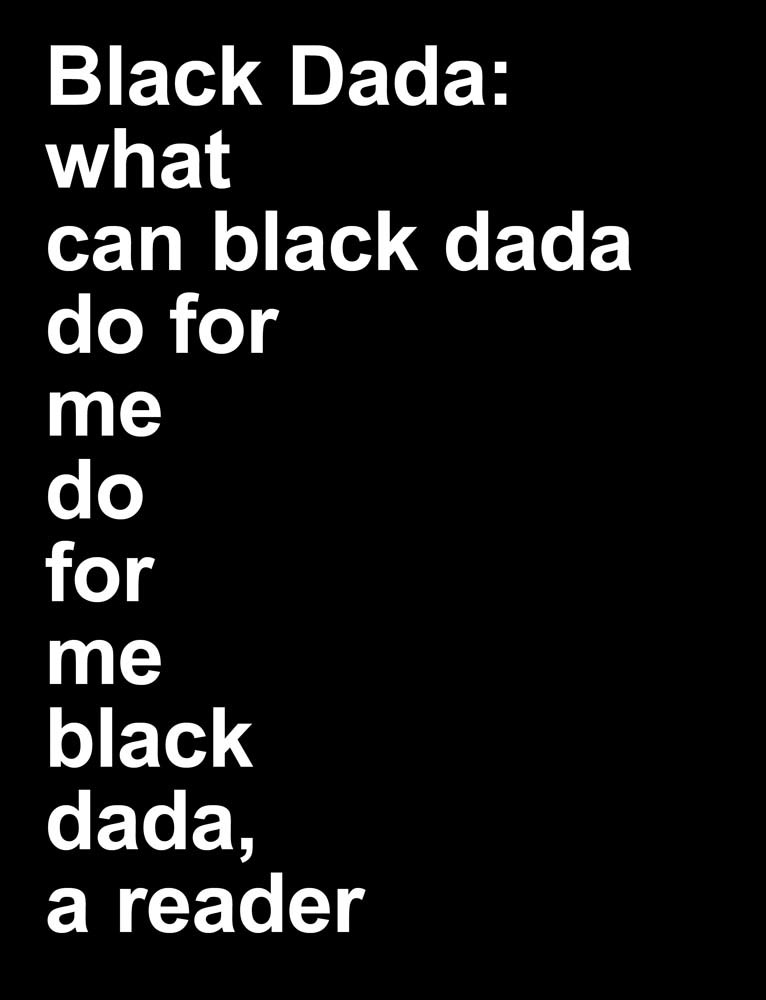
“Black Dada Reader is a collection of texts and documents that elucidates “Black Dada,” a term that acclaimed New York–based artist Adam Pendleton (born 1984) uses to define his artistic output. The Reader brings a diverse range of cultural figures into a shared conceptual space, including Hugo Ball, W.E.B. Du Bois, Stokely Carmichael, LeRoi Jones, Sun Ra, Adrian Piper, Joan Retallack, Harryette Mullen, Ron Silliman and Gertrude Stein, as well as artists from different generations such as Ad Reinhardt, Joan Jonas, William Pope.L, Thomas Hirschhorn and Stan Douglas. The Reader also includes essays on the concept of Black Dada and its historical implications from curators and critics including Adrienne Edwards (Walker Arts Center / Performa), Laura Hoptman (MoMA), Tom McDonough (Binghamton), Jenny Schlenzka (PS122) and Susan Thompson (Guggenheim).”
Edited by Stephen Squibb
Publisher Koenig Books, London, 2017
ISBN 9783960981053, 3960981058
331 pages
via tildaInterviews with author: Jess Wilcox (Art in America, 2009), Karlynne Ejercito (Artforum, 2016), Awa Konaté (Third Text, 2020).
Reviews: Yaniya Lee (Flash Art, 2017), Terence Trouillot (ArtNet, 2017), Robin Pogrebin (New York Times, 2018).
PDF (64 MB)
Tom Johnson: Imaginary Music (1974/2001)

“104 drawings with music notation symbols, many of which have been reprinted in magazines and as program covers. Perhaps the best known is the Celestial Music for Imaginary Trumpets, which ascends 103 ledger lines above the treble clef. Originally published in English only, a fourth printing of the volume was published in 2001 with titles in English and Spanish.”
Publisher Two-Eighteen Press, Carmel, NY, 1974
This edition by Editions 75, Paris, 2001
ISBN 0938690000, 9780938690009
104 pagesInterview with author: Bernard Girard (Contemporary Music Review, 2011/2020).
Nick Thurston: Of the Subcontract, or Principles of Poetic Right (2013) [EN, ES]
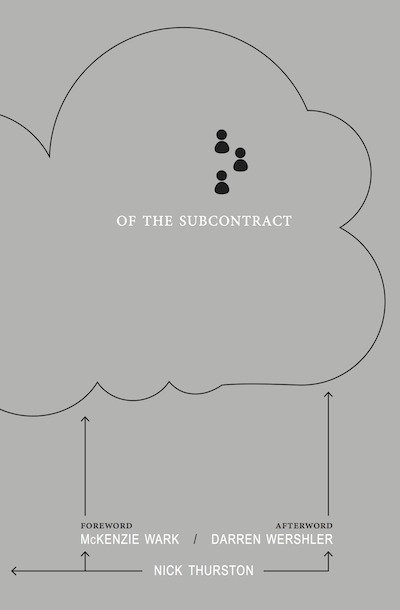
“Of the Subcontract is a collection of poems about computational capitalism, each of which was written by an underpaid worker subcontracted through Amazon.com’s Mechanical Turk service. The collection is ordered according to cost-of-production and repurposes metadata about the efficiency of each writer to generate informatic typographic embellishments. Those one hundred poems are braced between two newly commissioned essays; the whole book is threaded with references to Jean-Jacques Rousseau, Wolfgang von Kempelen, and the emerging iconography of cloud living.
Of the Subcontract reverses out of the database-driven digital world of new labour pools into poetry’s black box: the book. It reduces the poetic imagination to exploited labour and, equally, elevates artificial artificial intelligence to the status of the poetic. In doing so, it explores the all-too-real changes that are reforming every kind of work, each day more quickly, under the surface of life.”
Foreword by McKenzie Wark
Afterword by Darren Wershler
Publisher information as material, York, 2013
Creative Commons BY 3.0 Unported License
ISBN 1907468188, 9781907468186
144 pagesInterview with author: Stephen Voyce (Iowa Review, 2014).
Review: Rita Raley (American Book Review, 2014).Author
Publisher
Publisher (ES)
WorldCat
WikipediaOf the Subcontract (English, 2013)
De la subcontractar (Spanish, 2019)
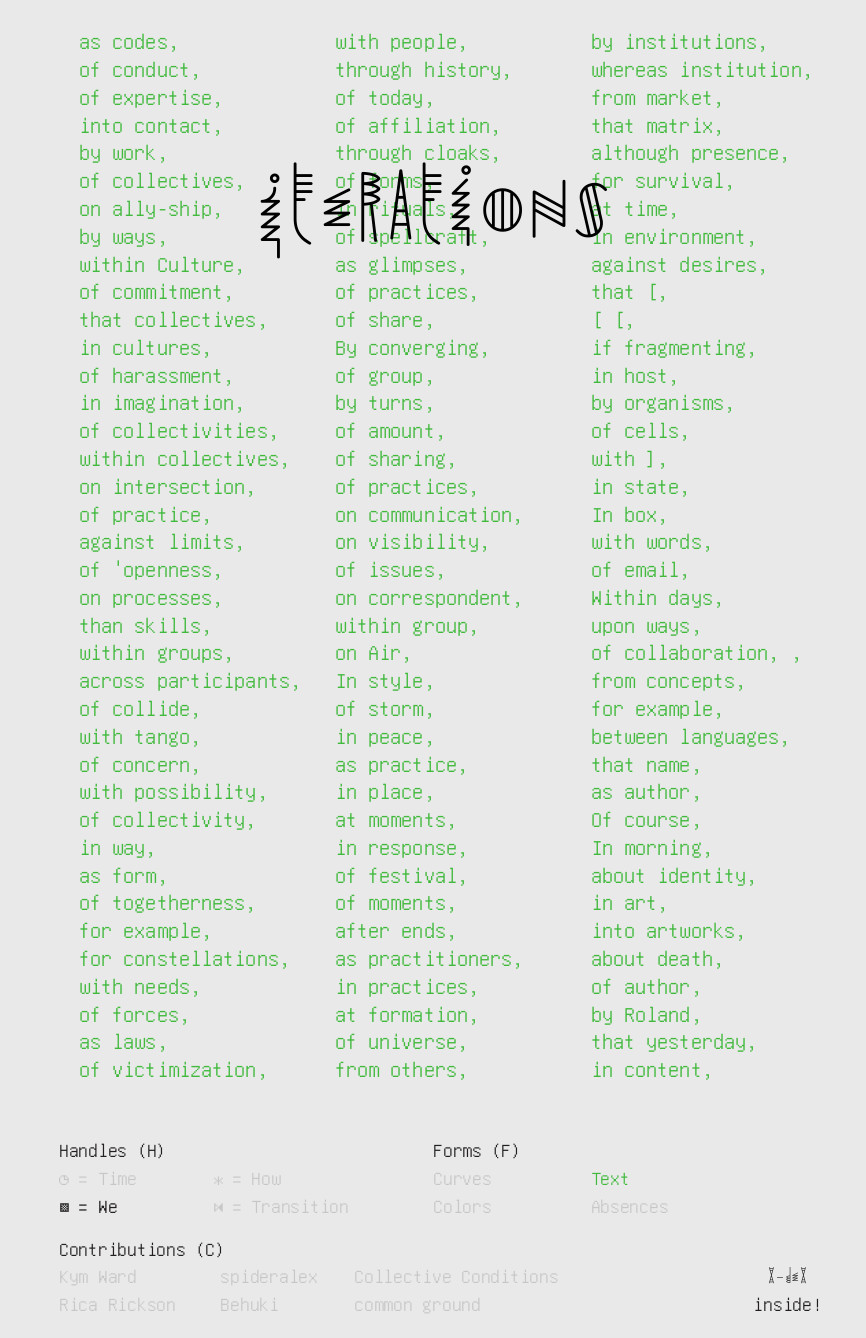
“Iterations was a series of residencies, exhibitions, research meetings and artistic exchanges committed to investigate the future of artistic collaboration in digitally networked contexts. Iterations is now also a publication that creates and inspires new concepts and openings for works yet to be developed.”
“The editors created a set of descriptions of common threads that were called ‘handles’, and invited each contributor to respond to one of them. During the ‘editorial sprint’ to process the material, scores were produced that allowed for a transversal reading of the contributions (see insert booklet). This practice was named ‘x-dexing’.”
With contributions by Kym Ward, Behuki, common ground, Rica Rickson, Collective Conditions, spideralex.
Editorial team: Jara Rocha, Manetta Berends, Lluís Nacenta, Nayarí Castillo, Peter Westenberg, Femke Snelting, Reni Hofmüller, Ludovica Michelin, Donatella Portoghese
Design by Manetta Berends
Publisher Constant, Brussels, May 2020
Free Art License
[172] & [40] pages
Tanja Ostojić: Lexicon of Tanjas Ostojić (2018)
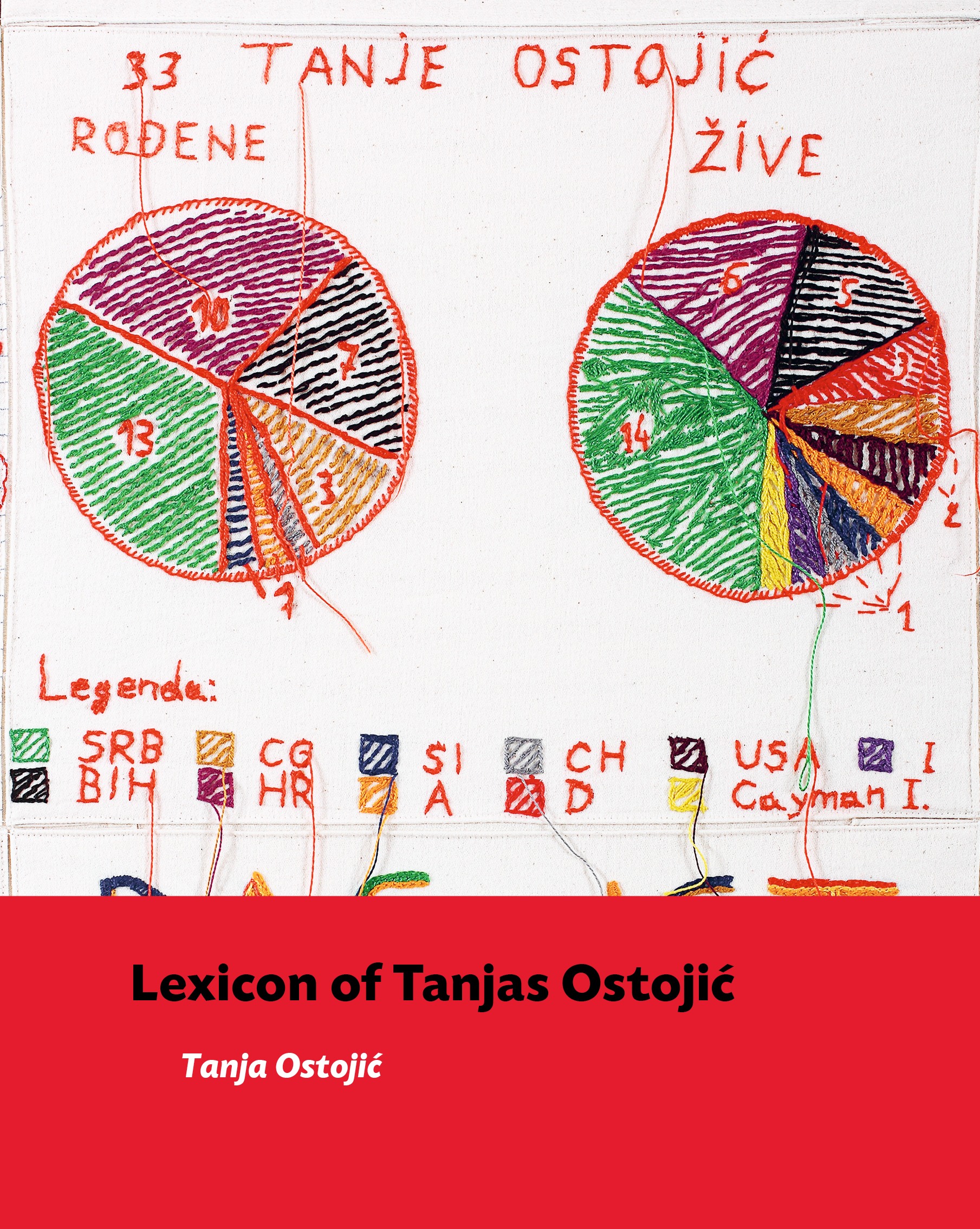
“This publication is based upon the Lexicon of Tanjas Ostojić (2011-2017), an interdisciplinary participatory research art project by Tanja Ostojić that included academic and artistic research, five creative workshops, a number of public events, one group performance, and two exhibitions involving more then 30 women.”
Edited by Tanja Ostojić
Publisher Live Art Development Agency, London, and Museum of Modern and Contemporary Art, Rijeka, 2018
ISBN 9780993561139, 0993561136
157 pages
via authorReviews: SeeCult (2017), Bojana Videkanic (Sociologija, 2018).
Interview with author: Matthew Rose (Artblog, 2018).Author
Exhibition (MoCAB, Belgrade, 2017)
Exhibition (MMSU, Rijeka, 2017)
Publisher (with audio recording from book launch)
WorldCatPDF (11 MB)
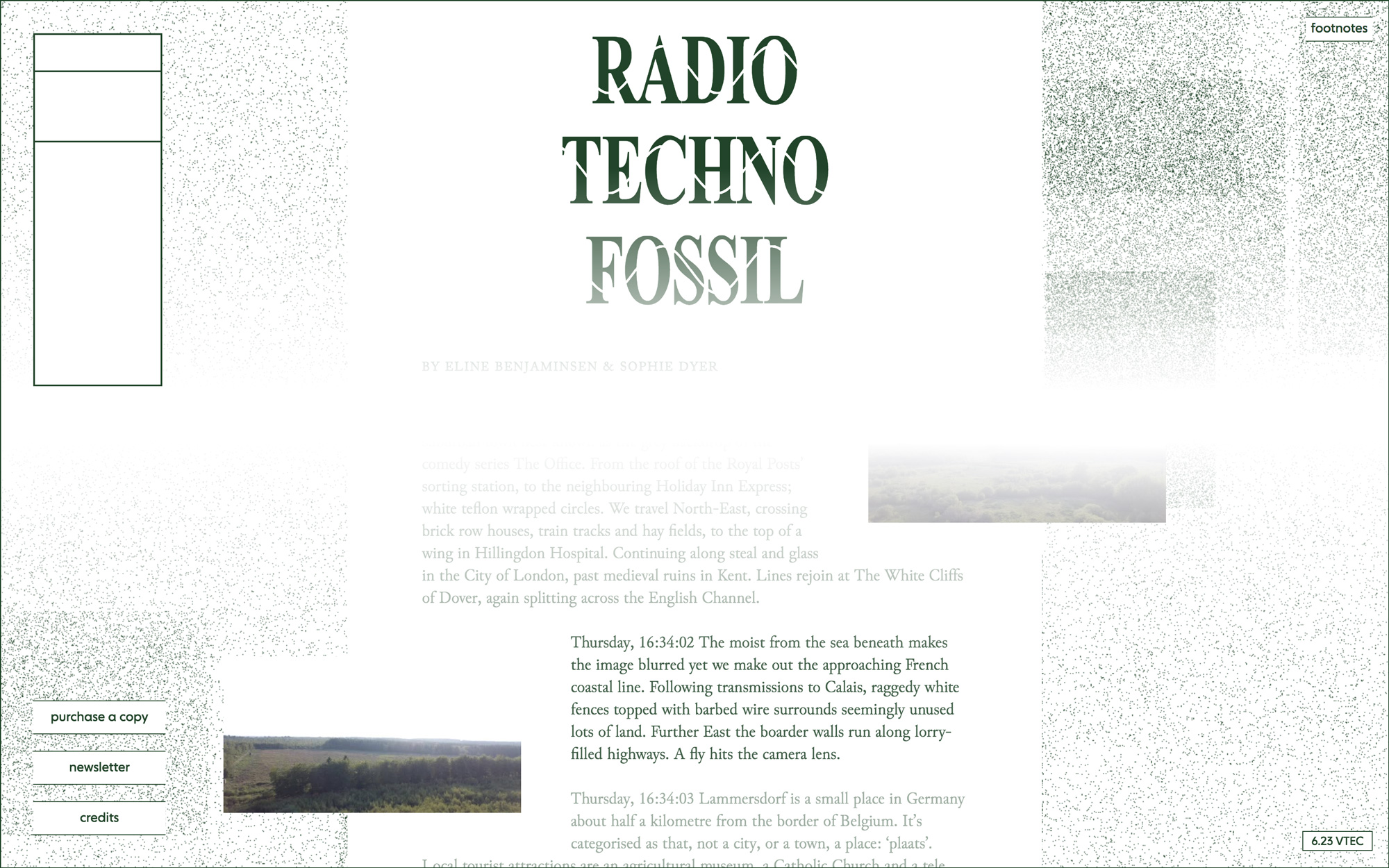
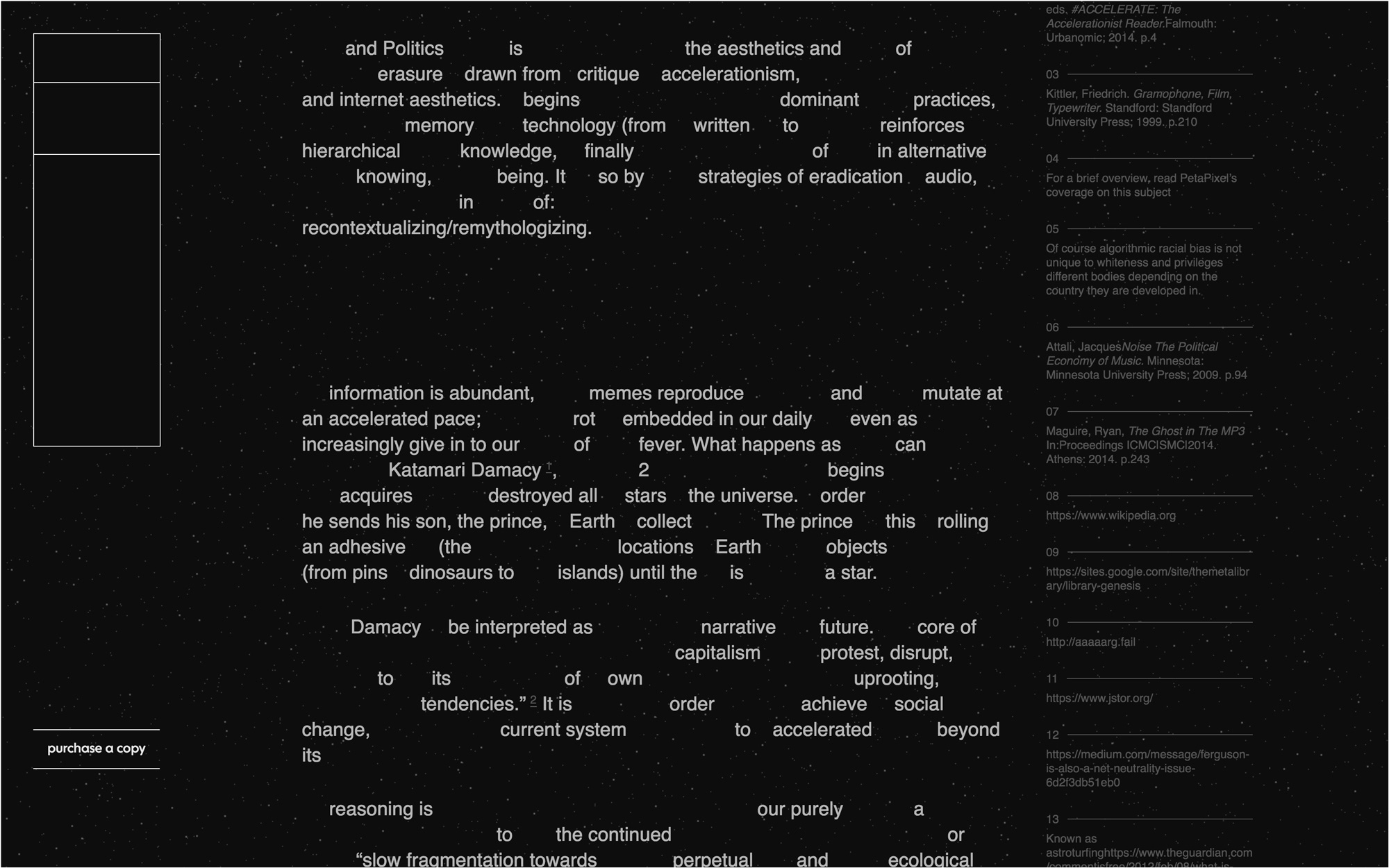
“oneacre.online is an experimental publishing and distribution project that utilises an online platform to seed unprintable text-based works by emerging artists. The project explores the possibilities of hyper-publishing in a series of commissioned publications. Thematically the first four place themselves in the online world of constant updates and refresh buttons that, as theorist Wendy Chun observes, “exist at the bleeding edge of obsolescence. We thus forever try to catch up, updating to remain the same”. The publications use the omnidirectional online terrain and actions that are native to it — such as refreshing, instantly available to edit, easily erasable, highlighting, copy-pasting and non linear navigation — to explore and critically evaluate visions and versions of power systems by tracing the politics of technological infrastructures. Hidden in places as traditional as archives, as often used as smart phone applications, omnipresent and inescapable as the financial market and as quiet and evasive as the transfer of information in narrative structures.
The series showcased in December 2017 Poetics and Politics of Erasure by Yun Ingrid Eel, a multidisciplinary research paper on the aesthetics and politics of erasure. In March 2018, Artificial Intelligence Never Has a Headache by Karina Zavidova, a long-form about the fear of AI spread by the media, and the market of productivity-enhancing tools it has fuelled. In July 2018 Radio, Techno, Fossil by Eline Benjaminsen & Sophie Dyer, the story of a radio-image as it traverses the bounds of the Earth’s surfaces, atmospheres and techno-geographies. And in September 2018, Meaning Seeking Animals by Lisa van Casand, a subjective collection of a wide range of perspectives on the transfer of information.”
Made by Stef Kors, Titus Knegtel, Victoria Douka-Doukopoulou
Published 2017-2018HTML (limited preview; use the direct links above to access publications)
Richard Avedon, James Baldwin: Nothing Personal (1964)
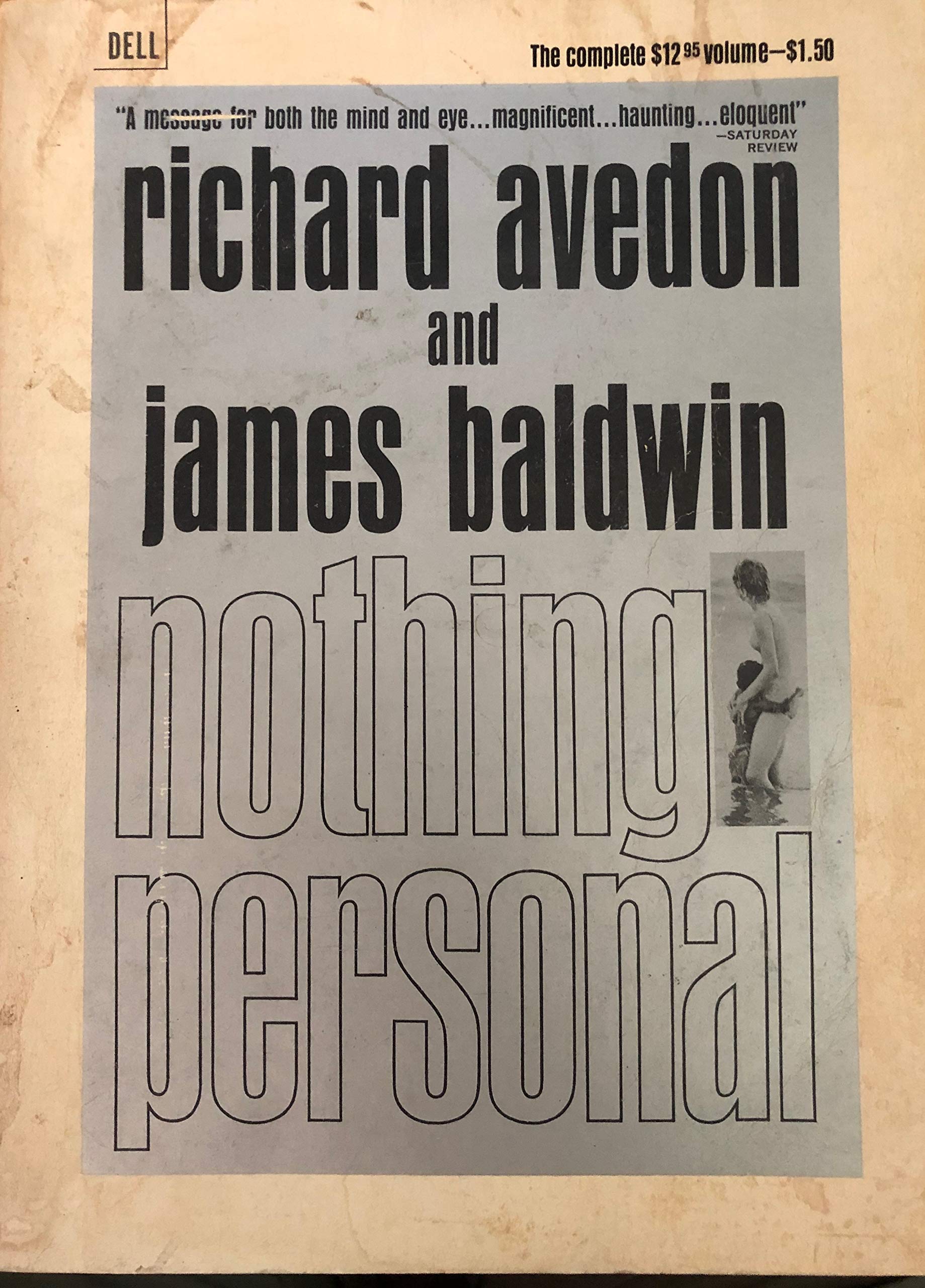
A book about the state of life in America. Photographs by Richard Avedon and text by James Baldwin.
First published by Atheneum, New York, 1964; and C. H. Bucher, Lucerne, 1964
This edition, Publisher Dell Publishing, New York, 1965
[88] pages
via Kelli AndersonInterview with Hilton Als (Antwaun Sargent, Galerie, 2017).
Commentary: Hilton Als (New Yorker, 2017).
Reviews: Brian Willis (Aperture, 2016), Steven W Thrasher (Guardian, 2017), Buzz Poole (LA Review of Books, 2018), Carmen Merport (LA Review of Books, 2018).PDF (9 MB)
JPGs
Reprint of Baldwin’s text
John Cage: A Mycological Foray – Variations on Mushrooms, 2 vols. (1972/2020)
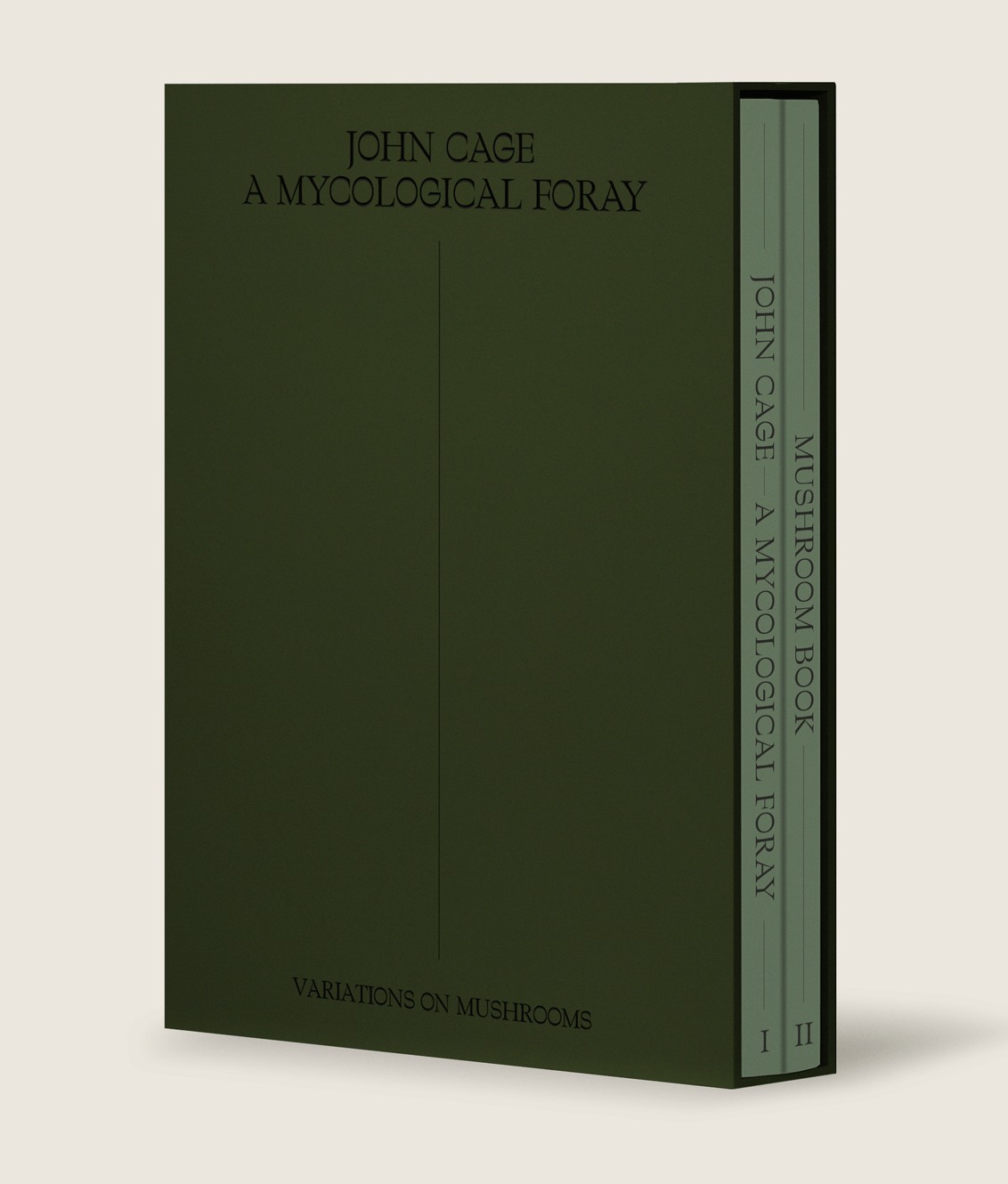
“John Cage: A Mycological Foray draws readers across the idiosyncratic, mushroom-suffused, innermost landscape of celebrated American composer John Cage. Upon the remarkable journey with Cage, one encounters assorted photographs, compositions, and contemplations; all in the very same unexpected fashion one encounters various flora and fungi species while mushroom foraging.
Volume I encompasses Cage’s mycological-oriented Indeterminacy stories, Diary excerpts, and essays; and the complete transcript of Cage’s 1983 performance, MUSHROOMS et Variationes.”
Volume II offers the inaugural reproduction of Cage’s 1972 portfolio, Mushroom Book, printed in 1972 in the limited run of 75 copies. The book is a study of fifteen different species of mushrooms, and each folio includes Cage’s poetry, sketches, and drawings (placed on the page by chance operations); scientific information about the mushrooms by Alexander H. Smith; and botanical illustrations by Lois Long.
John Cage: A Mycological Foray is developed in collaboration with the John Cage Trust.
With essay by Kingston Trinder and texts by Isabelle Bucklow.
Edited by Ananda Pellerin
Publisher Atelier Éditions, New York, 2020
ISBN 1733622004, 9781733622004
224 pages
via Alexandra Fanning, HT Georges VantongerlooPDF (watermarked file from publisher’s Dropbox, contains both volumes; no longer available as of 2 July 2020)
Danny Snelson: Apocalypse Reliquary, 1984-2000 (2018)

“Inhabiting an Earth continuously subjected to catastrophic events, Apocalypse Reliquary presents a survey of artifacts left behind by every recorded global cataclysm from 1984 to the present. Objects on display range from the circuit boards of Y2K to ejecta from the collision with Halley’s Comet. The exhibition includes spaceships from the Pleiades photon belt, the radioactive remains of countless nuclear armageddons, relics from the Zeta Reticuli star system, and a wide array of artifacts delivered by dozens of religious raptures.
Each entry in the Apocalypse Reliquary is inscribed within the ongoing disaster of the present. Organized chronologically, the catalogue begins in 1984, immediately following the collapse of the planet under the strain of the population bomb. The reliquary will continue to annotate the ruins of global annihilation until a final apocalyptic event renders all recording impossible.”
The book was produced on the occasion of Exhibition Library and first presented at an exhibition at the Seoul Museum of Art.
Publisher Monoskop, Amsterdam, and Mediabus, Seoul, 2018
[133] pagesPDF (82 MB)
See also follow-up to the project: Full Bleed: A Mourning Letter for the Printed Page (2019).
William Burroughs: Time (1965)
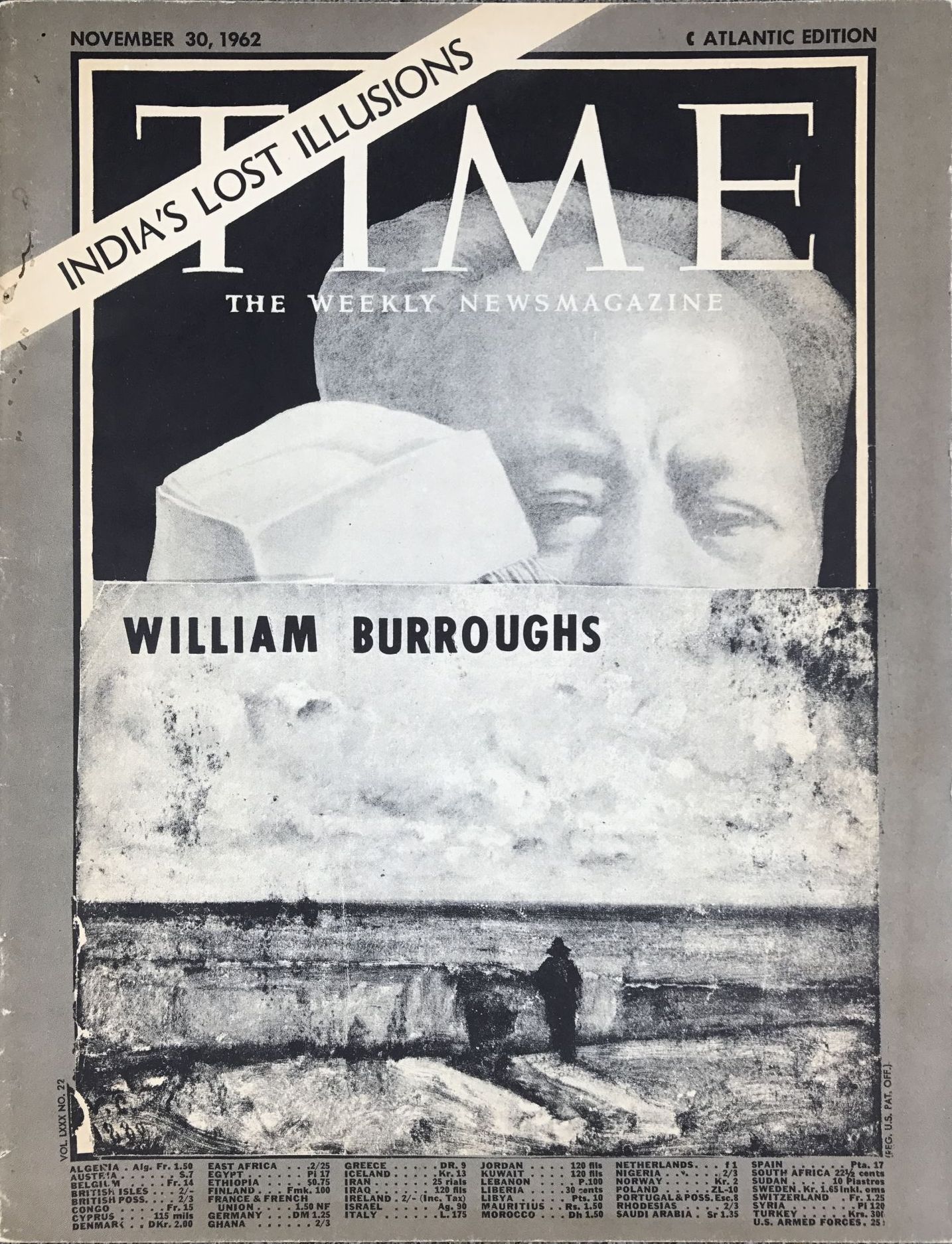
“Burroughs created his own version of Time magazine, including a Time cover of November 30, 1962, collaged over by Burroughs with a reproduction of a drawing, four drawings by Gysin, and twenty-six pages of typescript comprised of cut up texts and various photographs serving as news items. One of the pages is from an article on Red China from Time of September 13, 1963, and is collaged with a columnal typescript and an irrelevant illustration from the ‘Modern Living’ section of the magazine. A full-page advertisement for Johns-Manville products is casually inserted amid all these text; its title: ‘Filtering’.” (from Robert A. Sobieszek, Ports of Entry, 1996, 37)
The “Fliday Newsmagazine,” “Proclaim Present Time Over,” “File Flicker Tape” are some of the texts. The November 30, 1962 issue of Time was chosen, because the magazine reviewed the Grove Press edition of Naked Lunch in an article entitled “King of the YADS” (Young American Disaffiliates). The looming face of Mao symbolizing the threat of Red China adds an aura of nuclear disaster.” (Jed Birmingham, 2006)
With drawings by Brion Gysin
Publisher C Press, New York City, 1965
[28] pagesCommentary: Jed Birmingham (Reality Studio, 2006).
PDF (28 MB, via Reality Studio)
PDF (63 MB, via Goran Vejvoda)
Rosa Menkman: Beyond Resolution (2020)

“I opened the institutions of Resolution Disputes [i.R.D.] in March 2015, hosted by Transfer Gallery in New York. In September 2017, its follow-up Behind White Shadows opened, also at Transfer. Finally, in 2020 Shadow Knowledge found its way to SJSU Galleries in San José. At the heart of all three solo shows is my research into resolutions and together these exhibitions form a triptych framework for this publication: Beyond Resolution.
This little book also represents a journey spanning over 5 years, starting on a not so fine Saturday morning in early January 2015, when I signed the contract for a research fellowship in Amsterdam, to write a book about Resolution Studies.” (from Introduction)
Publisher i.R.D., 2020
ISBN 9789082827309
Copy-It-Right
[108] pages
via authorPDF (15 MB)
James Benning: Two Cabins (2011)
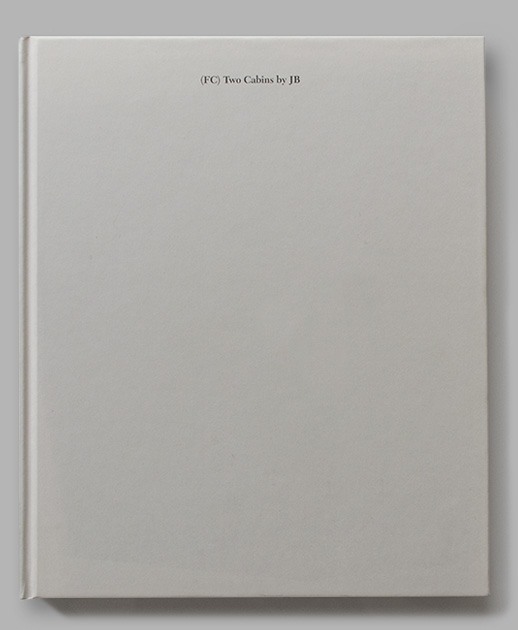
“This project based publication edited by Julie Ault documents and analyzes a body of work by the critically acclaimed filmmaker.
Benning reconstructed Henry David Thoreau’s and Ted Kaczynski’s iconic cabins, and uses these structures to reflect on utopian and dystopian versions of social isolation. Mounted on the walls of each cabin are copies of paintings by so-called outsider artists, also made by Benning. On the surface Benning’s two cabins are night and day, invoking contradictory sets of reclusive intentions and divergent paths leading back out. Deeper inquiry reveals the Thoreau / Kaczynski equation to be inspired. Benning’s engagement makes discernable a multitude of contacts between their motivations, beliefs, and experiences of seclusion. Benning’s armature artfully unfolds a complex articulation of practices of dissent, nonprescriptive ways of living, and the politics of solitude.
The book includes photography by Benning, essays by Julie Ault, Benning, and Dick Hebdige, and extracts from Thoreau’s and Kaczynski’s writings.”
Edited by Julie Ault
Publisher Art Resources Transfer, New York, 2011
ISBN 0923183485, 9780923183486
175 pages
via juleslineal, HT Auditory ScenesInterview with author (Brian Sholis, Artforum, 2012)
Publisher
WorldCat
Notes sur les mouvements (2013-2014) [French/English]
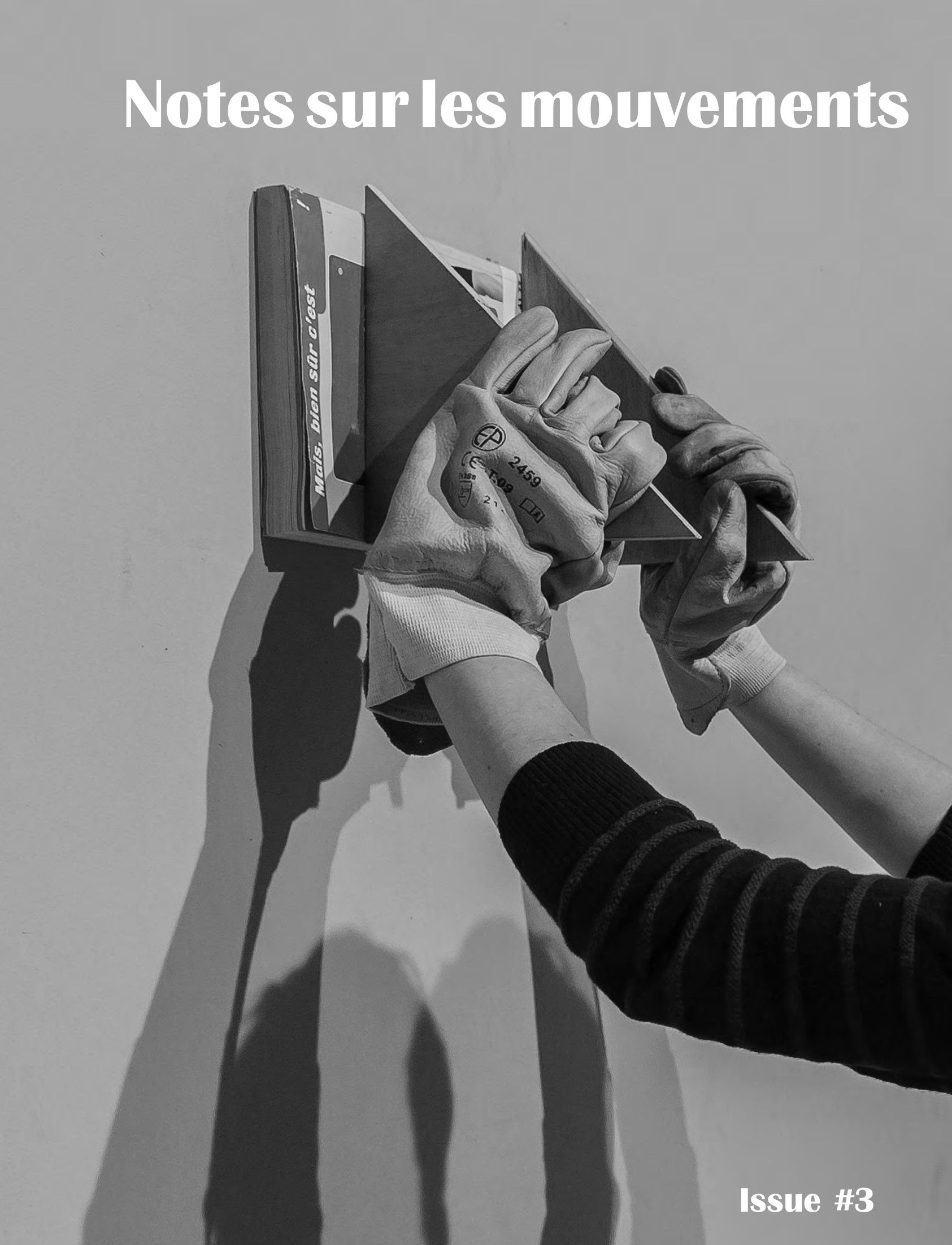
A free publication edited by Romana Schmalisch during her residency at Les Laboratoires d’Aubervilliers.
“The first issue analyses the conjunction of dance with Labour Movements of the 1930s (New Dance Group) as well as its use in the industry to enhance efficiency (Laban/Lawrence); it looks at the vague image that we have from various professions, researches the value of the performance of a work and its equivalence in the wage, and considers different forms of abstractions (notations and graphics) and training methods.”
“The second issue focuses on the question of education. In an interview, sociologist Anne Querrien discusses social norms and the school system. In her text, the London-based writer Marina Vishmidt revisits an earlier essay which considered the relationship between contemporary dance and the de-materialization of labour. What changes about this relationship as all employment becomes more and more of a brutal hypothesis in our post-crisis conditions?”
“The last, third, issue deals with what is at stake when one learns a job, with relationships between teachers and students, with various methods of education, and with the way these systems reflect certain social norms.”
Edited by Romana Schmalisch
Publisher Les Laboratoires d’Aubervilliers, Aubervilliers, 2013-2014
Open access
24 pages per issueIssue 1 (September 2013)
Issue 2 (March 2014)
Issue 3 (September 2014)
Mike Kelley: Plato’s Cave, Rothko’s Chapel, Lincoln’s Profile (1986)

Publisher New City Editions, Venice, CA, and Artists Space, New York, 1986
98 pagesReview: Artforum (1987).
Commentary: Jori Finkel (LAMA, 2014).Exhibition (Metro Pictures, New York, 1986)
WorldCatPDF (19 MB)
MP3 (Performed live with Sonic Youth, Molly Cleator and Adam Rudolf at Artists Space, New York, 5 December 1986. Recorded by Carole Parkinson. 38 min, via UbuWeb)
Ardengo Soffici: BÏF§ZF+18: Simultaneità e chimismi lirici (1915–) [Italian]

“BÏF§ZF+18 Simultaneità e Chimismi lirici [BÏF§ZF+18. Simultaneity and Lyrical Chemistry] is a poetry book and artist’s book published in 1915 by the Italian futurist Ardengo Soffici. Despite its rarity, the book has become famous as one of the finest examples of futurist ‘words-in-freedom’, and has been described as ‘absolutely the most important book that came out of Florentine Futurism’.
The book is divided into two roughly equal halves; the first, Simultaneità, contains 12 ‘simultaneous’ poems laid out in standard typography; the second section, Chimismi lirici, contains 10 poems that use multiple fonts, signs, adverts, brand names, repetition and onomatopoeiac devices that are contemporaneous to Marinetti‘s similar experiments in Zang Tumb Tumb, and prefigure Marinetti’s later, more abstract Les mots en libertés futuristes, 1919.” (Wikipedia)
First published by Voce, Firenze, 1915.
New, expanded edition
Publisher Vallecchi, Firenze, 1919
110 pages
via Bibliothèque KandinskyCommentary: Dirk Vanden Berghe (2012).
PDF (25 MB)

“Two books were published to accompany the 1929 Film und Foto exhibition in Stuttgart organised by the Deutscher Werkbund: Foto-Auge, edited by Franz Roh and Jan Tschichold, and Es kommt der neue Fotograf!, edited by Werner Gräff. With its cover of El Lissitzky‘s now famous Self Portrait of the artist as a hand in service to the eye celebrating the monocular medium (photography), Foto-Auge served both as an catalogue of the work exhibited as well as a visual polemic detailing László Moholy-Nagy‘s New Vision. Featuring work from the world’s leading modernist photographers, as well as anonymous news and bureau photos, Roh’s and Tschichold’s editing and sequencing energetically riff on the Bauhausian notion of enlightened objectivity.”
With photographs by Piet Zwart, John Heartfield, El Lissitzky, Eugène Atget, Andreas Feininger, Max Ernst, Herbert Bayer, Willi Baumeister, George Grosz, Gutschow, Florence Henri, Hannah Höch, Hans Leistikow, Max Burchartz, László Moholy-Nagy, Walter Peterhans, Man Ray, Albert Renger-Patzsch, Geert Paul, Hendrikus Schuitema, Maurice Tabard, Karel Teige, Grete Vester, Dsiga Wertoff, Edward Weston, Umbo, a.o. Introduction by Franz Roh (“Mechanismus und Ausdruck. Wesen und Wert der Fotographie”).
Publisher Akademischer Verlag Dr. Fritz Wedekind, Stuttgart, 1929
Designer Jan Tschichold
Printer Heinrich Fink
18+[76] pages, 30 x 21 cm
via ThebausCommentary: Inka Graeve Ingelmann (MoMA, 2014), Object:Photo exhibition (MoMA, 2014), Felix (Wiedler.ch, n.d.).
PDF (166 MB)
Linda Dement: Cyberflesh Girlmonster (1995)

“At the Adelaide Festival 1994, about 30 women donated body parts by scanning their chosen flesh and digitally recording sound. From these, conglomerate bodies were created, animated and made interactive.
When a viewer clicks on one of these monsters, the words attached to that body part could be heard or seen, another monster may appear, a digital video could play, a story or biological information about the physical state described by the story, may be displayed.
Cyberflesh Girlmonster is a macabre comedy of monstrous femininity, of revenge, desire and violence.”
The .iso also contains Linda Dement‘s work Typhoid Mary.
Published in Sydney, 1995
via Sandra FauconnierInternet Archive (Mac CD-ROM ISO, PDFs)
Video emulation (8 min)
Booklet PDF
Fred Moten, Wu Tang: Who Touched Me? (2016)

“Who Touched Me? is a compilation of research by Fred Moten and Wu Tsang, who together cohabit the roles of poet and performance artist. The publication traces the development of their sculptural performance Gravitational Feel, which was yet to be realized at the time the book was due to print. This book introduces the reader to this work in its virtual state, while tracing Moten and Tsang’s lived experience of collaboration through a body of text, which is composed of email correspondence, notes, poetry, fragments of essays, and transcriptions of earlier collaborative work. Together these entwined texts create a new socio-poetic form. To quote from the book’s pages, ‘The research/experiment is in how to sense entanglement.'”
Introduction by Frédérique Bergholtz and Susan Gibb
Publisher If I Can’t Dance, I Don’t Want To Be Part Of Your Revolution, Amsterdam, 2016
Performance in Residence series
ISBN 9789492139061, 9492139065
61 pagesPDF (9 MB)
Diane Arbus: An Aperture Monograph (1972)

A monograph composed of 80 photographs, edited and designed by the painter Marvin Israel, Diane Arbus’ friend and colleague, and by her daughter Doon Arbus.
Text edited from tape recordings of a series of classes given by Diane Arbus (1923-1971) in 1971 as well as from interviews and some of her writings.
Published in conjunction with a major exhibition of the photographs of Diane Arbus at the Museum of Modern Art.
Publisher Millerton, New York, 1972
ISBN 0912334401, 9780912334400
15 pages, 80 unnumbered leaves of plates, 29 cmPublisher
Open Library
WorldCatPDF (44 MB)
See also
<video controls id="video21061" width="320" height="240" poster=""><source src="https://monoskop.org/media/film/Going_Where_Ive_Never_Been_The_Photography_of_Diane_Arbus_1972.mp4" type="video/mp4" /></video>
Going Where I’ve Never Been: The Photography of Diane Arbus, documentary, dir. John Musilli, 1972, 28 min. MP4 (65 MB), via
Geraldine Juárez: Flux until Sunrise (2018)

“The book combines an interview with Esther Leslie about Materialismo Mágico with documentation of my material exploration of what she refers as the Liquid Crystal Epoque. The book includes the recipes for LCD and Gorilla screen-glazes.”
Publisher Rojal, Gothenburg, 2018
ISBN 9789198492835
[50] pages
Zoe Beloff: Emotions Go to Work (2018)
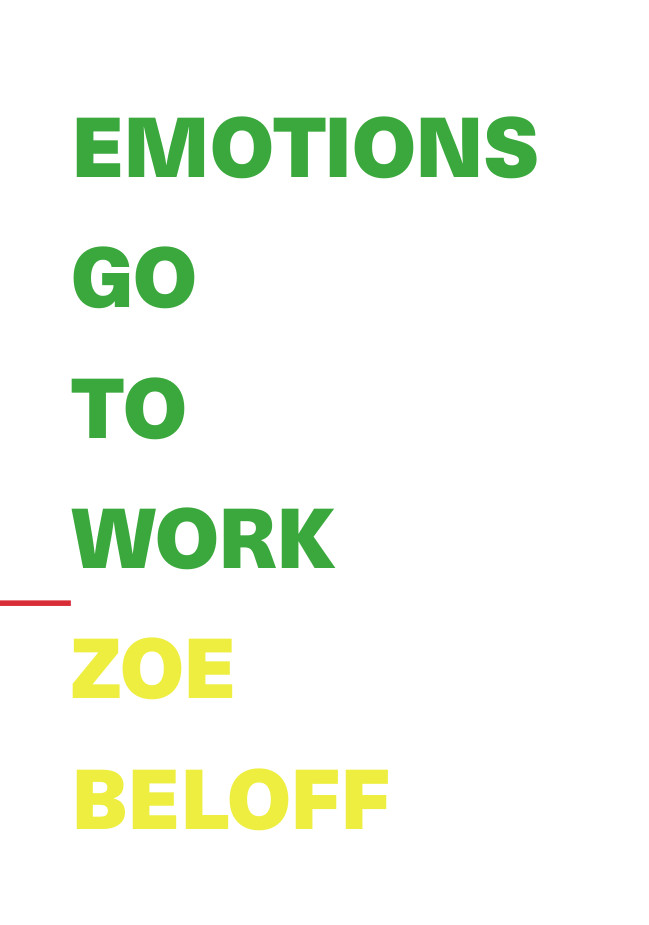
“Emotions Go to Work is an investigation into how technology is used to turn our feelings into valuable assets. One might call it the transformation of emotion into capital. It asks what is at stake in our relationship with the companions we call smart objects? What does the future hold in store for a world where people are treated more and more like things, while the billions of gadgets that make up the Internet of Things are increasingly anthropomorphized, granted agency?
Spanning an arc of time from the 18th century to 21st century and beyond, Emotions Go to Work traces the codification and instrumentalization emotional data in ways both playful and serious. It considers the role emojis play our mental life and their potential to evolve and grow monstrous. It suggests that anthropomorphized technological creatures from early cartoons might inspire a utopian society. Proposing that the first step to re-wiring our world is to picture possibilities in games and in play, in dreams and in far-fetched fictions, so that we can begin new conversations between people and things.”
Publisher Minor Compositions, Colchester, 2018
Open access
ISBN 9781570272301
59 pagesPDF (12 MB)
Purple Noise: An Exhibition Turned Into an Global Feminist Protest Turned Into a Catalogue (2018)

“In the summer of 2018, a German artist, famous for having a past as cyberfeminist and a present as technofeminist, was invited to Stuttgart in the South of Germany, to create an exhibition dealing with issues of gender and technology as part of a large festival. During her research, she got in touch with numerous fellow artists and activists, and in a process of collective realization, they found that the time has come, not for another exhibition, but for a global technofeminist upheaval.
Learning from the dark forces that understand how to manipulate national referenda and presidential elections, they flooded social media platforms – an area they had previously avoided in order to protest against the centralisation and privatisation of digital communication. Very quickly, however, they have learned how to “motivate” thousands of followers, how to “inspire” them to like and “share” their contents, and even to contribute their own agendas. Within a few weeks, what had started as a small protest, has grown exponentially and conquered not just the Net but also traditional media. They gained enormous power, more than they ever imagined, and now decisions have to be made on how to use this power. Come and help us decide! What would you do if you had power over the Internet – and thus the real world?”
Produced for Monoskop’s Exhibition Library in the 2018 Seoul Mediacity Biennale, 6 September–18 November 2018 at the Seoul Museum of Art.
Self-published in collaboration with Monoskop, Amsterdam, August 2018
[14] pagesPDF (4 MB)
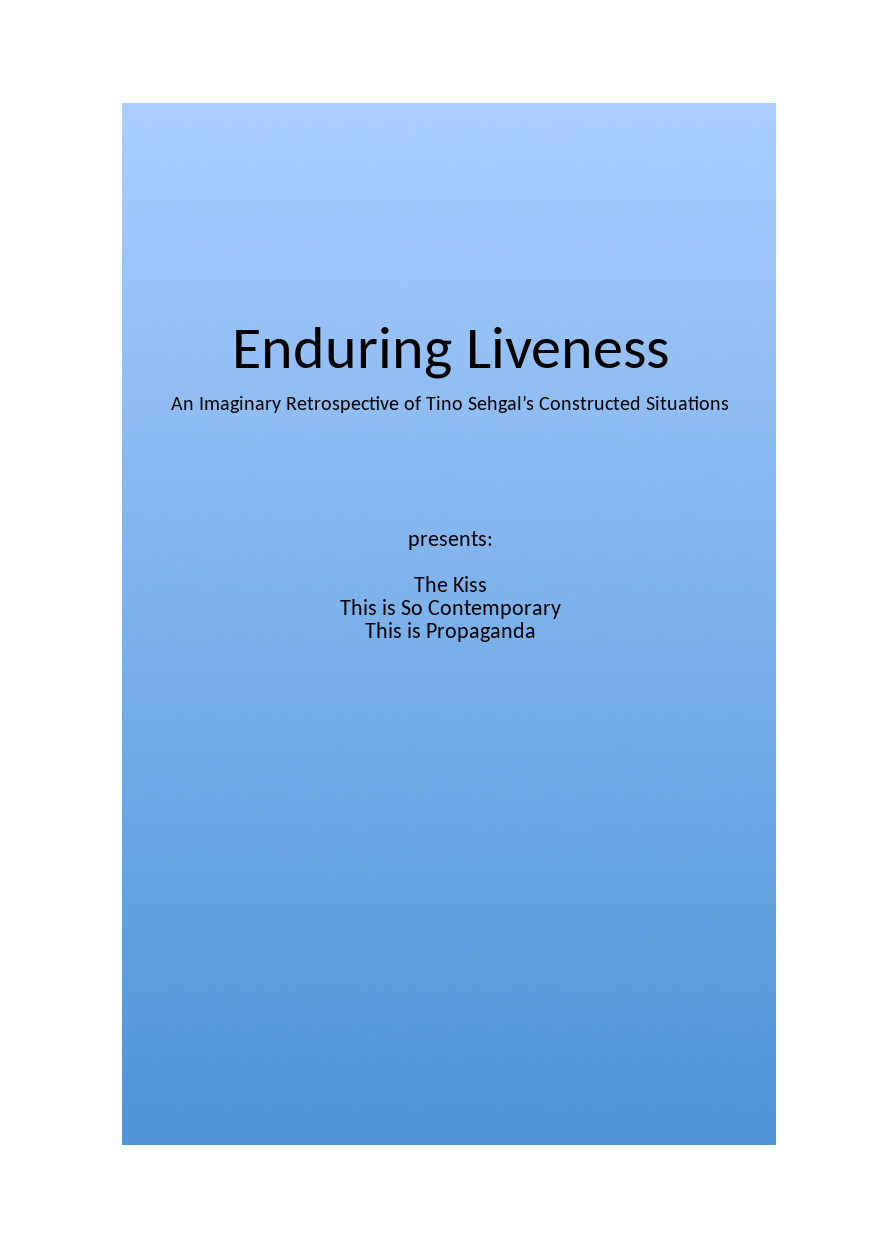
“The key functions of a museum are the collection, presentation, preservation and education of cultural and artworks for the enjoyment of, and to educate, the public. Performance art has been notoriously difficult for museums to handle, despite the ‘easy’ presentation the non-materiality of the art form challenges the conventional methods and practices of a museum. Artist Tino Sehgal had added to these problems, persisting in having no documentation of his performances, or better his ‘constructed situations’, in whatever form or way. While several books and some catalogues are written about his work, none of them show visual representations of the actual performances.
While I sympathize with Sehgal’s aims and ideas, I’m also intrigued by the numerous ways in which documentation developed and expanded in the last two decades with more and more photos and videos appearing online. In this catalogue three perspectives are presented that open up the potential of documentation as a method to generate new articulations and ways of understanding, thinking and performing. Countering the “no photos allowed” from the press statements of the museums, with the documentation used by online news outlets and those created by visitors, the experience of being present at the performance can no longer be considered as a fixed or even final perspective. Instead the constructed situations continue to act through viewing, capturing and circulation. Navigating the various documents that are created idiosyncratically according to access (having a camera and an Internet connection) or choice (having the willingness or courage to take an image and change the rules), the Imaginary Retrospective of Tino Sehgal adds to what theatre and performance scholar Sarah Bay-Cheng beautifully describes as “a multi-valent experience that is shaped and constructed by the individual experiences, choices, and negotiations of all parties within a connected network of information, sensations, and varying access points” (2012). At the same time, it might open up a desire for new performance to emerge.”
Produced for Monoskop’s Exhibition Library in the 2018 Seoul Mediacity Biennale, 6 September–18 November 2018 at the Seoul Museum of Art.
Self-published in collaboration with Monoskop, Amsterdam, August 2018
89 pagesPDF (14 MB)
Sam Hart, Sarah Hamerman: Secrets at Mediacity Seoul (2018)
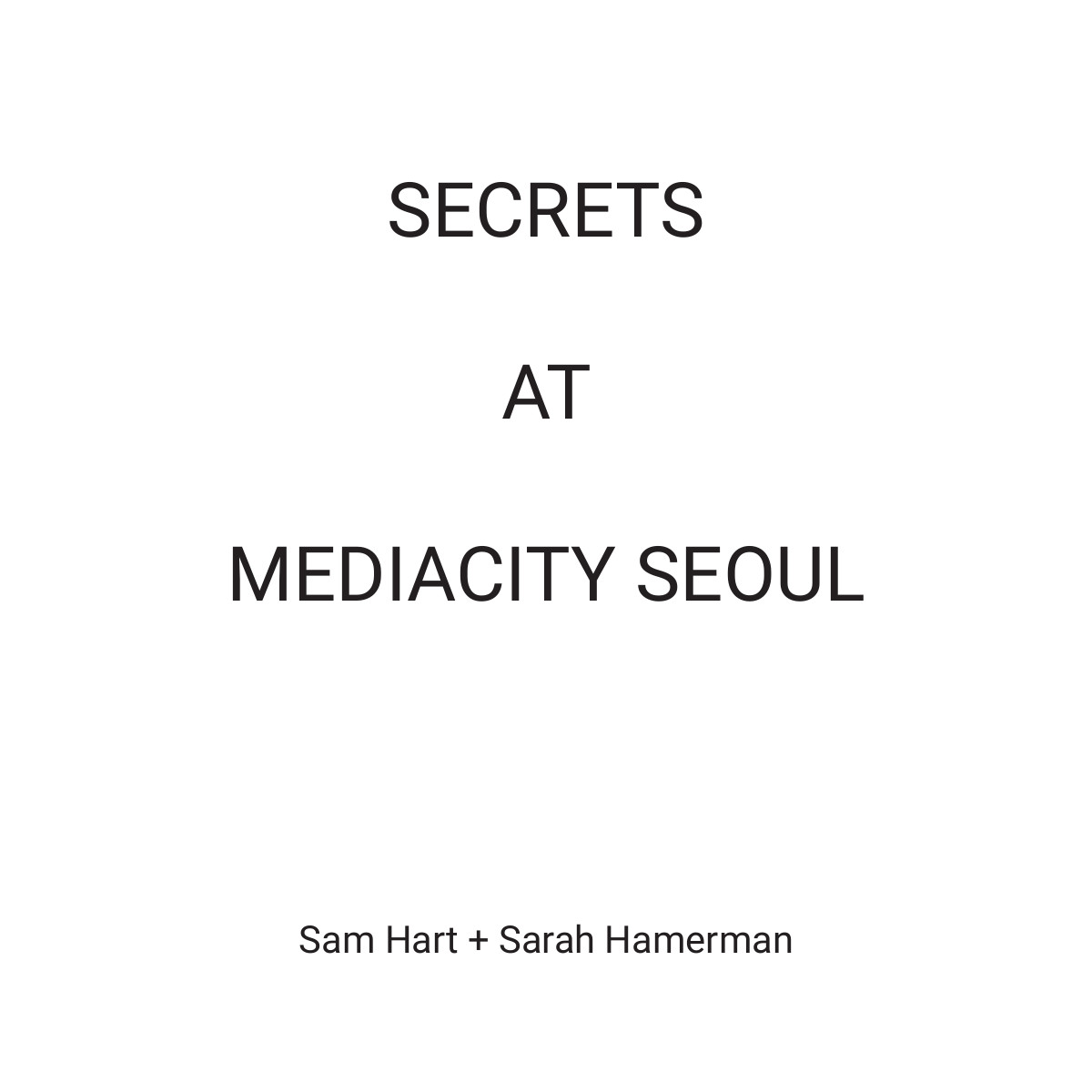
“Secrets at Mediacity Seoul traces a genealogy of artworks that examine the secret as an information structure, from the conceptual artworks of the 1960s to works that consider secrecy and encryption in today’s social and technological context. While conceptual art’s logic of dematerialization often undergirded an aesthetic of ‘pure’ information, it led artists from Douglas Huebler and Robert Barry to Mel Ramsden and Sophie Calle to investigate how secrets test the limits of what can be known and seen. But the role of secrets is political as well as epistemological. Works by artists such as Trevor Paglen, Jill Magid, Paolo Cirio and Hayal Pozanti consider how secrets organize the distribution of power, from algorithmic “black boxes” and state classification schemes, to new digital infrastructures built upon cryptographic primitives. Finally, Secrets at Mediacity Seoul looks beyond the catalogue’s documentary role, imagining how it might conceal or encrypt the absent artworks. The Secrets at Mediacity Seoul forms part of the Secrets research and curatorial project (2017-2018), a collaboration between Sarah Hamerman and Sam Hart. ”
Produced for Monoskop’s Exhibition Library in the 2018 Seoul Mediacity Biennale, 6 September–18 November 2018 at the Seoul Museum of Art.
Self-published in collaboration with Monoskop, Amsterdam, August 2018
[20] pages
Ilan Manouach: Katz (2011) [French]
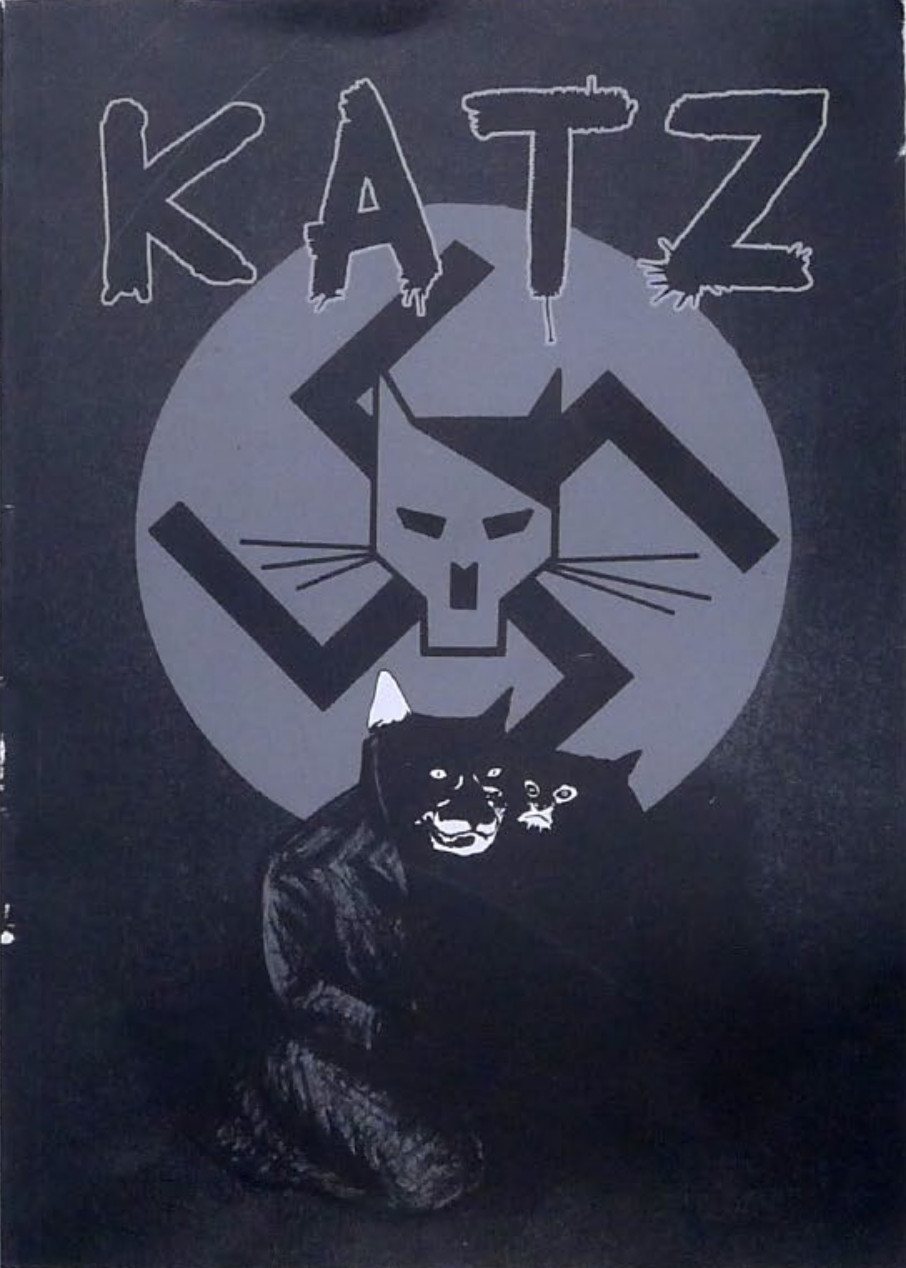
“Katz is a pirated edition of Art Spiegelman’s seminal graphic novel Maus. Katz is an exact copy of the French edition of Maus, with the difference that all the animal characters, have been redrawn as cats. The book was printed on November 2011 and it was seen in public for the first time in January 2012 during the International Comics Festival of Angoulême that ran under Spiegelman’s presidency. Apparently more than 50 copies were sold simultaneously by several independent publisher bookstands, but the book’s ISBN belonged clearly to La Cinquième Couche, a Belgian publishing structure which had already a large catalogue under its belt. The author of this pirated edition was presumably Ilan Manouach. After the Festival, the book was scheduled to be officially distributed by April 2012 and according to Belles Lettres, the distributor, it has already been sold out in pre-order from hundreds of bookshops in France and Belgium. BLDD asks for a reprint but the author and the publisher refuse, underlining the repurposing as a statement.
Two weeks before the book hits officially the book stores, the lawyers of Flammarion, the copyright holder of the French edition of Maus strike back. They send to Mr. Manouach and Mr. Löwenthal, a 500-page document containing spreads from both Maus and Katz, interviews from Ilan Manouach, and his correspondence with Art Spiegelman. Refusing to take on account the conversational nature of the operation and its very limited printrun, Katz is stated as a counterfeit of Maus and Flammarion seeks an injunction against the small Belgian press.
There is also some fuss about the number of copies. The book was printed in Greece and the infringing publisher handled many contradictory proofs of the total print run. The sum fluctuates between 700 and 2000 copies. Flammarion, in the report, states that probably 100 books are hidden in Greece. The same week, in Athens, people break into Manouach’s car and steal 32 books.
La Cinquième Couche and Manouach are positive about the trial. A century of art history, from Duchamp to pop art is enough to prove the validity of this operation. Nevertheless, being already heavily indebted, the publisher, not able to afford the 20.000 starting costs in order to fight the injunction, accepts an out of court settlement: nothing more or less than the total destruction of the books and the digital files. The operation took place in Brussels the 15 march 2012, in a specialised destruction facility.”
Publisher La Cinquième Couche, Ixelles, 2012
ISBN 2930356847, 9782930356846
286 pages
via UbuWebInterview with author (M. Hulot, Ough, 2012, English)
Interview with author (Xavier Guilbert, du9, 2012, French)
Commentary: Bill Kartalopoulos (World Literature Today, 2016)Author
Wikipedia
Publisher
WorldCatSee also Xavier Löwenthal, Ilan Manouach (eds.), MetaKatz, 2013.
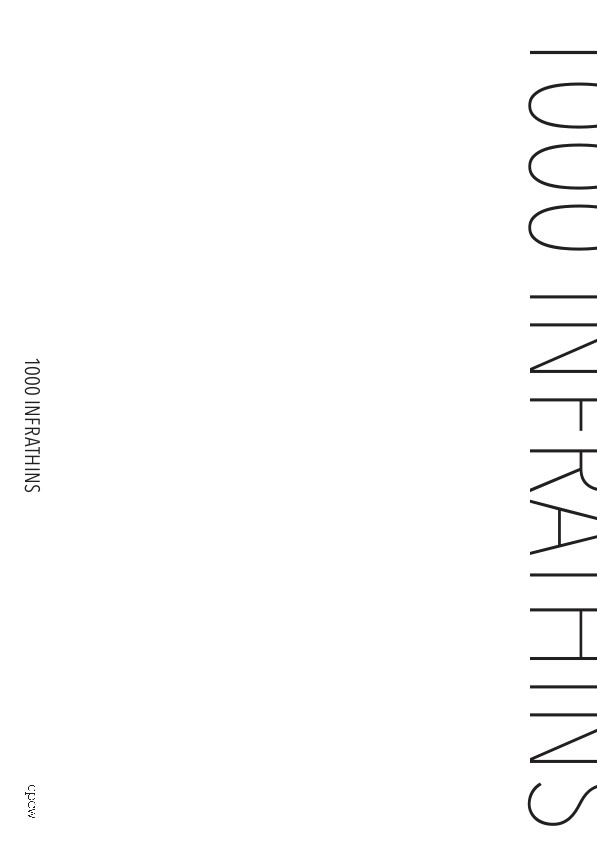
“Marcel Duchamp gave six instances of the infrathin. We wrote 1000 of them.”
“What is infrathin? It’s not really clear. Purposely. The French word inframince (translated into English as infrathin) was coined by Marcel Duchamp, but in typical Duchampian fashion, he claimed that it couldn’t be defined. Instead, he insisted that one could only give examples of it. Over the course of his life, he gave a few:
– The warmth of a seat (which has just/been left) is infra-thin.
– When the tobacco smoke smells also of the mouth which exhales it, the 2 odors marry by the infra-thin.
– Velvet trousers, their whistling sound is an infra-thin separation signaled.Without getting too specific, we can surmise that infranthin is the space between spaces, the sound between sounds, the sensation between sensations; neither here nor there, this nor that, but both—all at the same time. The closest metaphor is the fourth dimension, which is best illustrated by a cube collapsing in on itself and at the same time expanding. I know. It’s not very helpful. But that’s the whole point—it’s a moving target, a ball of contradictions; just when you think you’ve got it, it’s escaped you.”
Edited by Kenneth Goldsmith
Authors: Cecily Chen, Andrew Howard, William Kahn, Grace Knight, Jonida Kupa, Amy Marcus, Charlie Sosnick, Zoe Stoller
Publisher The Center for Programs in Contemporary Writing, University of Pennsylvania, 2018
121 pages
Derek Beaulieu: a, A Novel (2017)
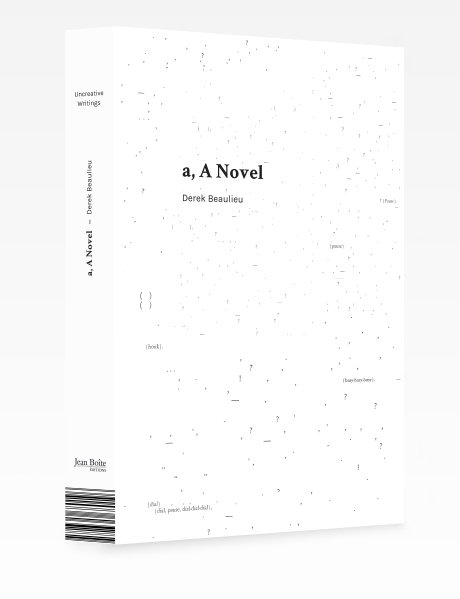
“Derek Beaulieu’s a, A Novel is an erasure-based translative response to Andy Warhol’s eponymous novel. Beaulieu carefully erases all of the text on each page of the original work, leaving only the punctuation marks, typists’ insertions and onomatopoeic words. The resultant text is a novelistic ballet mécanique, a visual orchestration of the traffic signals and street noise of 1960’s New York City. This visually powerful half score/half novel highlights the musicality of non-narrative sounds embedded within conversation.
Published in December 1968, Andy Warhol’s a, A Novel consists solely of the transcribed conversations of Factory denizen Ondine (Robert Olivo). Ondine’s amphetamine-addled conversations were captured on audiotape as he haunted the Factory, hailed cabs to late-night parties and traded gossip with Warhol and his coterie. The tapes were roughly transcribed by a small group of high school students. Rife with typographic errors, censored sections, and a chorus of voices, the 451 pages of transcription became, unedited, “a new kind of pop artefact”. These pages emphasize transcription over narration, hazard over composition.
In his book, Derek Beaulieu offers a radical displacement of Andy Warhol’s work. He erases the novel’s speaking characters – members of the mid 1960’s New York avant-garde – and preserves only the musicality of their conversations. Beaulieu perfectly provides a tangible example of Theodor Adorno’s theory elaborated in his essay ”Punctuation Marks”, in which he argues that punctuation marks are the “traffic signals” of literature and that there is “no element in which language resembles music more than in the punctuation marks”.
This visual poetry is accompanied by an essay by Gilda Williams, “Breaking Up is Hard to Do. Men, Women, and Punctuation in Warhol’s Novel a”. Her deep knowledge of both Andy Warhol’s work and the history of contemporary art explores the complicated history of the original novel and highlights the urgent and precise spirit of Derek Beaulieu’s work—the work of an artist who situates Uncreative Writing at the core of contemporary literature and artistic labour.”
Publisher Jean Boîte Éditions, Paris, 2017
ISBN 9782365680196
478 pages
via authorPDF (24 MB)
Pauline Oliveros: Sonic Meditations (1974)

“25 meditations for musicians of all ages and skill levels, to help them learn how to focus on, listen to, and produce sound naturally. An important work in the development of Oliveros’ Deep Listening.”
Publisher Smith Publications, Baltimore, MD, [1974]
[33] pagesCommentary: Pauline Oliveros (Painted Bride Quarterly, 1976), William Osborne (2000), Kerry O’Brien (New Yorker, 2016), Bradford Bailey (The Hum, 2016), Emma Warren (Bowers & Wilkins, 2017).